Numerous reports have suggested that Apple will incorporate body temperature monitoring as a feature in its upcoming Apple Watch Series 8.
Apple is not alone in evaluating this novel feature. According to several reports, Samsung Galaxy Watch 5 is expected to feature a similar feature. The latest beta edition of the One UI Watch 4.5 software shows a feature that can help measure skin temperature during sleep.
Contents
- 1 How temperature monitoring works in wearables
- 2 What is Core Body Temperature?
- 3 Current Wearables and body temperature monitoring
- 4 What about Apple Watch and body temperature monitoring?
- 5 Wearables that monitor your body temperature today
- 6 Three Major Areas of use for Body Temperature monitoring in the current market
- 7 Body Temperature Monitoring Use Cases Beyond Sports and Fertility Tracking
- 8 Final thoughts
Related reading:
- Apple’s new patent details elements of the rumored body temperature sensor
- Galvanic Skin Sensor technology on wearables is just getting started
- Sleep science and wearables, health applications beyond your usual sleep metrics
- Set up medication reminders on your Apple Watch and iPhone with the Health app
- Slaying hot flashes: wearables and apps help manage menopause and perimenopause symptoms
As an Amazon Associate, we earn from qualifying purchases using links in this post.
How temperature monitoring works in wearables
So is the core body or skin temperature just an indicator for checking if you have a fever?
Nope.
There’s more coming with this aspiration from the wearable giants and established wearable players like Oura and WHOOP.
This article explores the current state of peripheral temperature monitoring via wearables. We look at five different researched back use cases that can be addressed if a body temperature sensor is integrated into the latest smartwatches and wearables.
Before we get into some of the detailed use cases, let’s take some time to understand what body temperature is and explore the current state of affairs regarding wearables monitoring temperature.
Let’s get started with some of the basics.
What is Core Body Temperature?
Core body temperature is the temperature of the internal organs, such as the liver, heart, and brain, located deep within the body.
The human body maintains its core temperature within a narrow range of [97.7-101.3 °F].
Is Core Body Temperature the same as skin temperature?
Getting the core body temperature today involves invasive medical procedures in the hospital or clinical setting.
So it is usually a person’s peripheral body temperature (their ‘skin level’ temperature) that is commonly measured in non-invasive sites such as the mouth, ear, armpit, and (less frequently) rectum because these areas are easily accessible and are believed to provide the best estimation of the core body temperature.
However, there can be as much as a 1 – 2 degrees difference between the actual core body temperature and a peripheral (skin) temperature measurement.
Significance of Body temperature during Sleep / Night
Our core body temperature hovers around 98.6 degrees Fahrenheit (37 degrees Celsius) but fluctuates by about 2 degrees Fahrenheit throughout the night.
Core body temperature follows a 24-hour cycle linked with the sleep-wake rhythm.
Body temperature decreases during the night-time sleep phase and rises during the wake phase.
Sleep is most likely to occur when core temperature decreases and is less likely to occur during the rises.
Edd Harding and Nicolas Franks conducted a comprehensive study explaining how your sleep patterns are influenced by temperature.
The authors hypothesized that thermoregulatory circuits themselves might have an essential role in facilitating sleep.
This would also explain the propensity of either external or direct PO warming to induce NREM sleep.
Non-rapid eye movement (NREM) sleep episodes are also accompanied by core and brain cooling.
Current Wearables and body temperature monitoring
Given that smartwatches today offer some form of body temperature monitoring, we wanted to take a deeper look at what is available today.
Fitbit body temperature monitoring
Fitbit’s premium platform offers users a snapshot of their skin temperature.
If you have a Fitbit Versa 3 and subscribe to their premium offering, you see the variations in your nightly skin temperature over the week.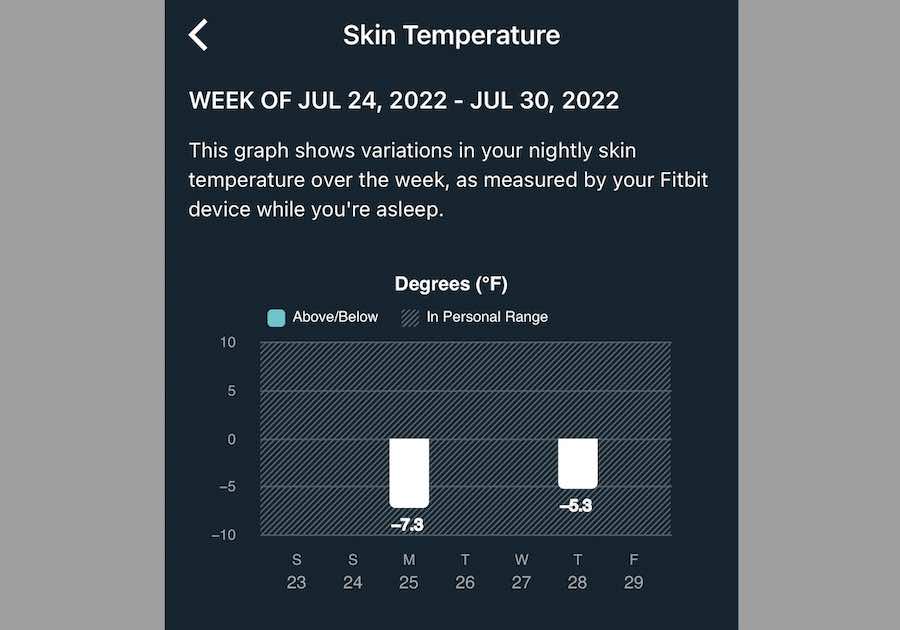
However, this Fitbit feature only provides the data when you monitor sleep while wearing your Fitbit device. Plus, you must subscribe to Fitbit Premium to see these details.
The latest Fitbit watch, Fitbit Sense, also includes the feature where it tracks your nightly skin temperature during sleep.
Samsung Galaxy Watch 5 body temperature
The same is true with the upcoming Samsung Galaxy 5 watch. (based on One UI Watch 4.5 beta screenshots).
The Galaxy Watch collects snapshots of your skin temperature while you are sleeping.

However, recent reports suggest that this feature may not be available on the upcoming Galaxy Watch 5.
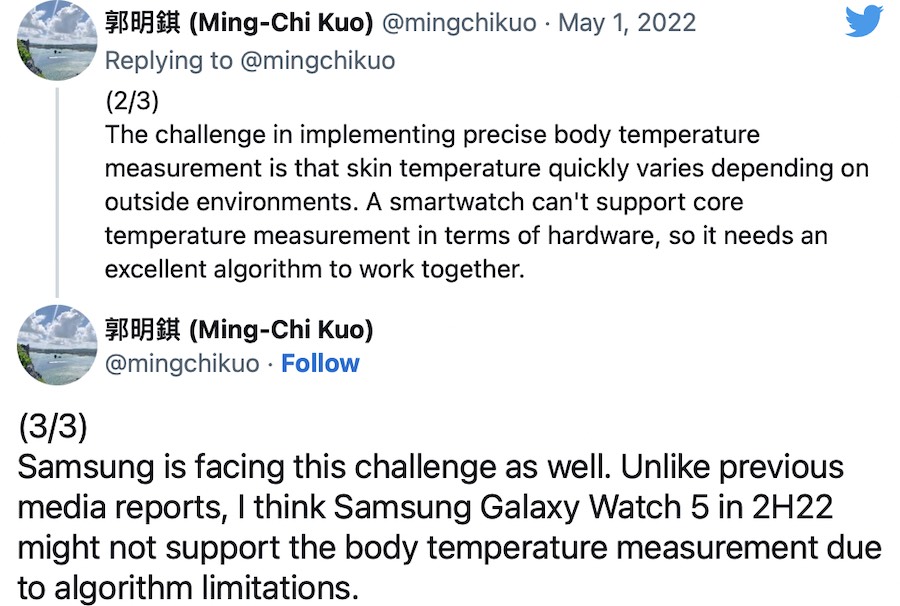
According to Ming-Chi Kuo, Samsung is “facing challenges” in bringing body temperature measurements to the Galaxy Watch 5. The analyst believes the functionality won’t be available with the upcoming release later this year.
Garmin Watches
In the case of Garmin wearables, the watches do not directly measure the skin temperature.
There is, however, an estimated body temperature data field available on a Garmin device accessed via ConnectIQ.
According to Garmin, Estimated body temperature is an experimental data field that displays estimated core body temperature based on heart rate during physical activity.
This is only an estimate of core body temperature.
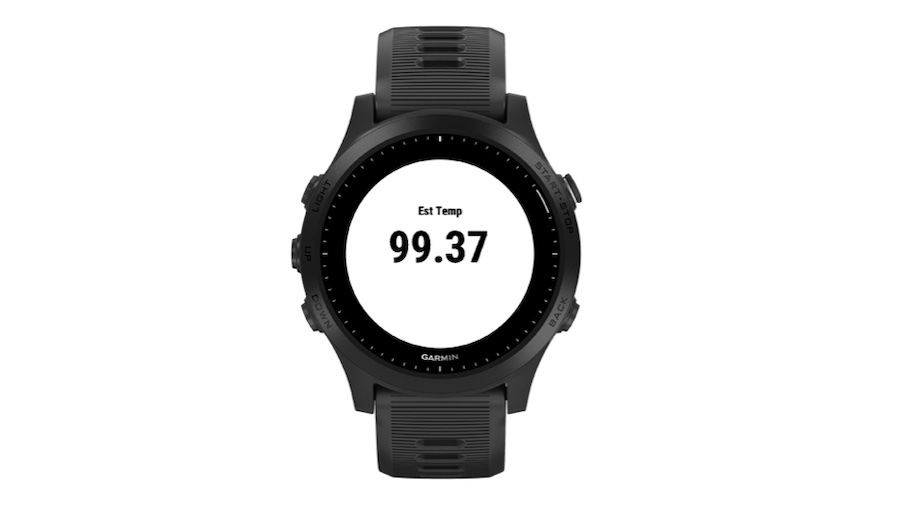
Most of the new Forerunner, Venu, Vivoactive, and Fenix models offered by Garmin can provide this using the body temperature widget.
Again, this is just an estimate instead of an actual sensor monitoring your skin temperature continuously.
Please note that Garmin does offer a dedicated temperature sensor module that can be attached to its watches.
This product is called Garmin Tempe BUT it only provides you the ambient temperature reading and not your body temperature.
- Temperature Sensor
- Outdoor watch.Transmit ambient temperature data wirelessly to your device with the tempe external...
If you were looking for a device that can accurately show you the ambient temperature of a location, this might be a good and affordable choice. It attaches to your existing Garmin Smartwatch (check compatibility).
Oura Ring
The folks at Oura have been doing some fascinating research on skin temperature.
In fact, Studies show that the Oura Ring could detect changes in heart rate variability (HRV) and daytime skin temperature that signal an upcoming LH surge.
The researchers were looking for signs of the LH surge, a sudden hormone increase that acts as the “go signal” for the release of an egg (ovulation).
In innovative fertility research, the Oura ring has proven some novel benefits in measuring skin temperature.
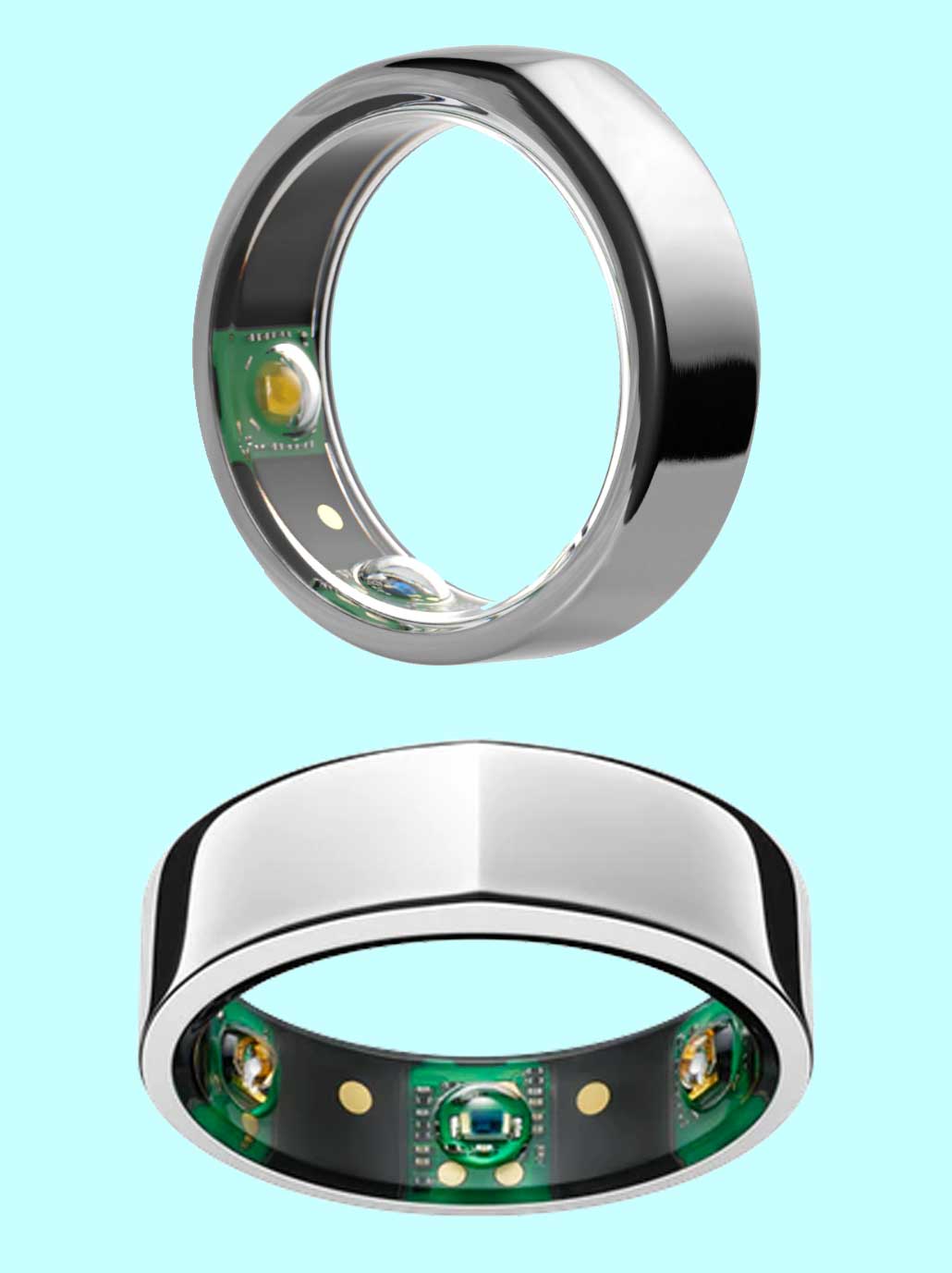
The distal temperature, as mentioned in Berkeley’s QCycle project, is a critical component in understanding ovulation.
Wearable devices offer unprecedented ease in collecting the continuous, longitudinal data needed to assess URs (Ultradian rhythms) and CRs(Circadian rhythms) across the menstrual cycle. The Oura ring provides personalized and continuous temperature data.
If you own an Oura Ring, you can see the data on the app by going to the Readiness tab and tapping Body Temperature.
The data you see here is the skin temperature, not the core temperature.
Wearables such as the Garmin devices use outward-facing sensors to estimate your temperature based only on your external environment or approximate it based on your heart rate. In contrast, the Oura ring reads your temperature directly from your finger.
In the case of Oura and WHOOP, the skin temperature is associated with your ‘Recovery’ scores.
The central hypothesis is that your body’s ability to maintain an ideal temperature range indicates whether your system is stressed and needs rest or ready to tackle the day’s training load.
What about Apple Watch and body temperature monitoring?
Oh well…It’s the usual story.
Apple is never first on a feature but introduces a much-refined feature when it does introduce one.
The Apple Watch models available today do not measure or estimate your body temperature.
According to a report published by Mark Gurman at Bloomberg, this is likely to change with the upcoming Apple Watch Series 8.
Is Apple behind in body temperature monitoring?
In terms of actually having the feature on the watch or the AirPods, Apple is behind.
That being said, if you take a deeper dive into some of the company’s research, you will see that the Cupertino giant has been thinking about body temperature for some time now.
We looked at the research put forth by Christopher Prest and Quinn Hoellwarth from Apple in one of the company’s early patents, “Sports Monitoring System for Headphones Earbuds and Headsets.”
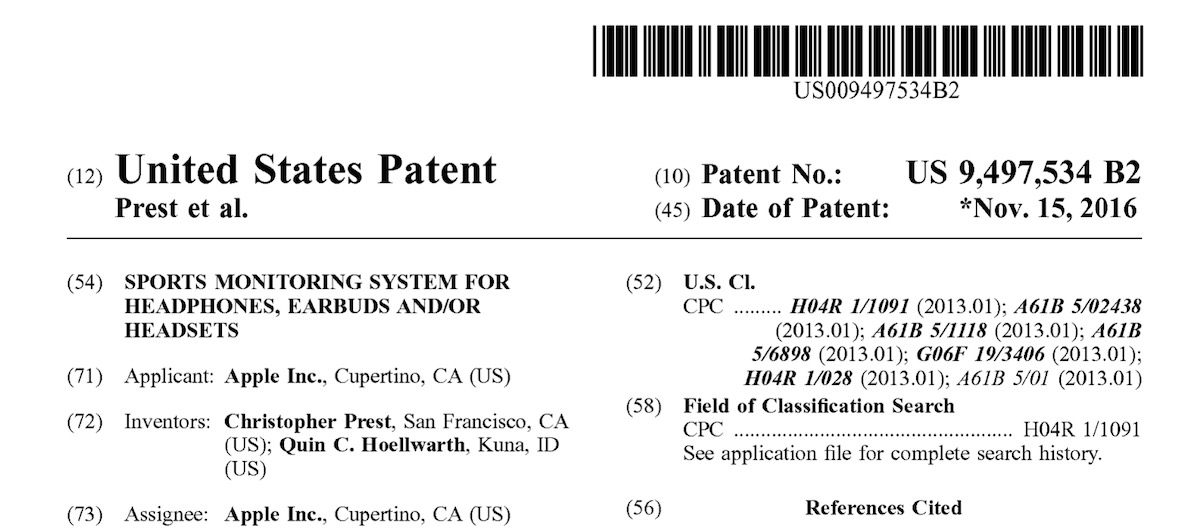
Chris Prest used to head the product design engineering at Apple as a Director and is currently a Senior Director in Materials Engineering and Product Design at Apple.
The central idea of the patent is that earbuds can not only help with monitoring sports activity but also assist with monitoring Perspiration, heart rate, and temperature tracking.
It’s important to note that the idea put forth in this patent predates AirPods. The patent images actually show you the old wired earbuds.
This is also one of Apple’s early patents for interpreting head movements and gestures.

In summary, it remains to be seen what Apple makes available on the Series 8 Apple Watch when measuring body temperature.
Incorporating an Infrared Thermopile sensor to read peripheral skin temperature will not be a significant accomplishment.
It remains to be seen what Apple actually does with the data in the form of user insights as it revises its watchOS software in the future.

“The temperature feature should appear in this year’s models, but the blood-pressure technology probably won’t arrive until 2025.”, says Gurman in his July 24th, 2022 newsletter. You can learn about the latest from this Macrumors article.
Wearables that monitor your body temperature today
Apart from Oura ring, other niche players offer wearable products that assist in monitoring your body temperature.
One of the wearables that offer this is CORE. The company provides a small sensor that can monitor body temperature and is used by serious athletes and sports scientists.
![]()
According to the company, “When exercising your core body temperature rises and as this rises, your performance (power) goes down. Monitoring your core body temperature will give you the knowledge and insights to improve your performance.”
For folks who are into endurance sports, this can be helpful.
The central premise is that as the body heats and diverts more energy to pump blood to the skin to cool the body, less blood powers the muscles, and power output drops.
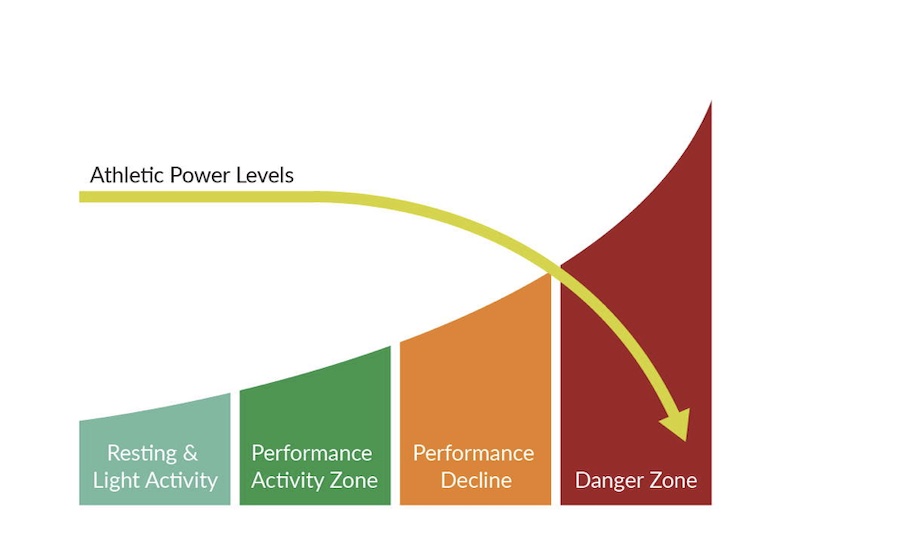
This is aligned with the Apple patent that we mentioned above, where the objective is to measure your perspiration and body temperature.
You see so many endurance athletes using water bottles to cool themselves by tipping the bottle of water over their head or body because it will cool down the skin temperature, and the body can dedicate more power to the sports performance.
The wearable made by CORE provides you with 24/7 core body temperature monitoring, but it costs a whopping $268!! Just to measure the temperature.
A leading wearable often used in decentralized clinical trials is Empatica’s E4.
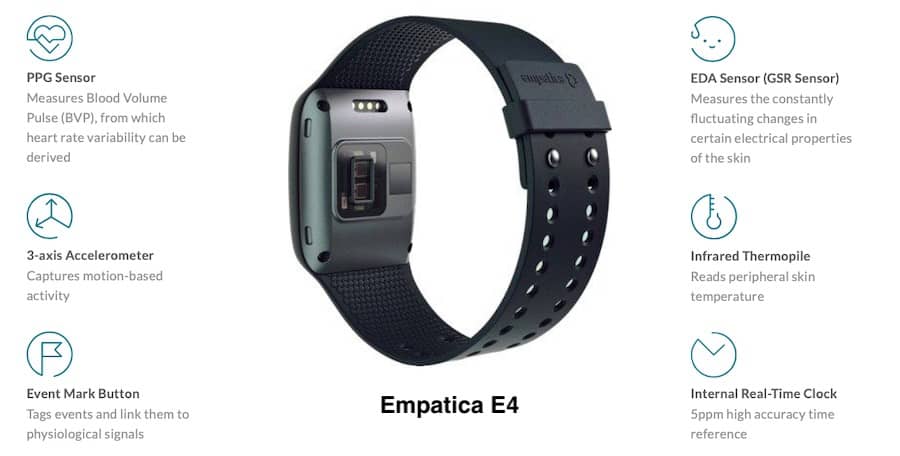
This is one of the wrist-based wearables that can read real-time peripheral skin temperature; however, the main audience for this wearable is the scientific and research community. The E4 costs almost $1700, according to Empatica’s site.
Three Major Areas of use for Body Temperature monitoring in the current market
There are a variety of products today that offer body temperature monitoring for two specific use cases. These are:
Fertility and Ovulation Tracking
– A huge market has been left untapped by the big tech players who manufacture wearables.
Oura seems to have a lead over other smart wearables when it comes to this. The company provides a service that can help track your menstrual cycle based on your skin temperature.
This space is huge in commercial terms, and there are both large players with FDA approvals, such as AVA SCIENCE wearable.
One of the first health apps to receive FDA approval was Natural Cycles.
The algorithm can evaluate the days of the month a woman is likely to be fertile based on daily body temp readings.
Using Natural Cycles, you are expected to enter daily temperature readings into the app manually.
If you have the Oura ring, you can integrate it with the Natural Cycles app and obtain detailed insights into fertility tracking.
AVA Fertility tracker, available for $279, is essentially a wrist band with a sensor that tracks your body temperature automatically.
Research has shown that for women interested in maximizing the chances of pregnancy, wrist skin temperature continuously measured during sleep is more sensitive than BBT(Basal body temperature) for detecting ovulation.
Endurance Sports, Recovery, and Body temperature monitoring
This is a smaller market compared to fertility and ovulation tracking.
Although wearables such as WHOOP and Oura have emphasized the “Recovery” component of their platform, people are slowly beginning to understand concepts such as Heart Rate Variability and body temperature regarding athletic recovery.
Unfortunately, there isn’t much standardization regarding defining and using the word “Recovery Score”.
For example, Garmin’s “Body Battery level” does not consider your actual body temperature.
WHOOP 4.0 does monitor your skin temperature, BUT only nightly skin temperature.
Although there are many smartwatches on Amazon promising you accurate body temperature measurements and priced below $50, we are not sure about the ability of these devices to provide you with an accurate body temperature reading.
That said, if you are serious about getting a core body temperature sensor, you may want to explore products from CORE and the OURA ring or wait for the Apple Watch Series 8 and see what services the company builds around the new temperature sensor.
Sleep Science and the role of body temperature
This is an area where nightly body temperature will play a huge role. It is not surprising that companies such as Samsung, Fitbit, and Whoop are starting to provide users with a reading of their nightly body temperatures.
Mayo Clinic has also explored the effect of different sheets on body temperature and sleep using a clinical trial.
Companies such as Eight Sleep have invested significant dollars into research around thermal regulation and sleep and have started offering innovative products such as their Pod 3.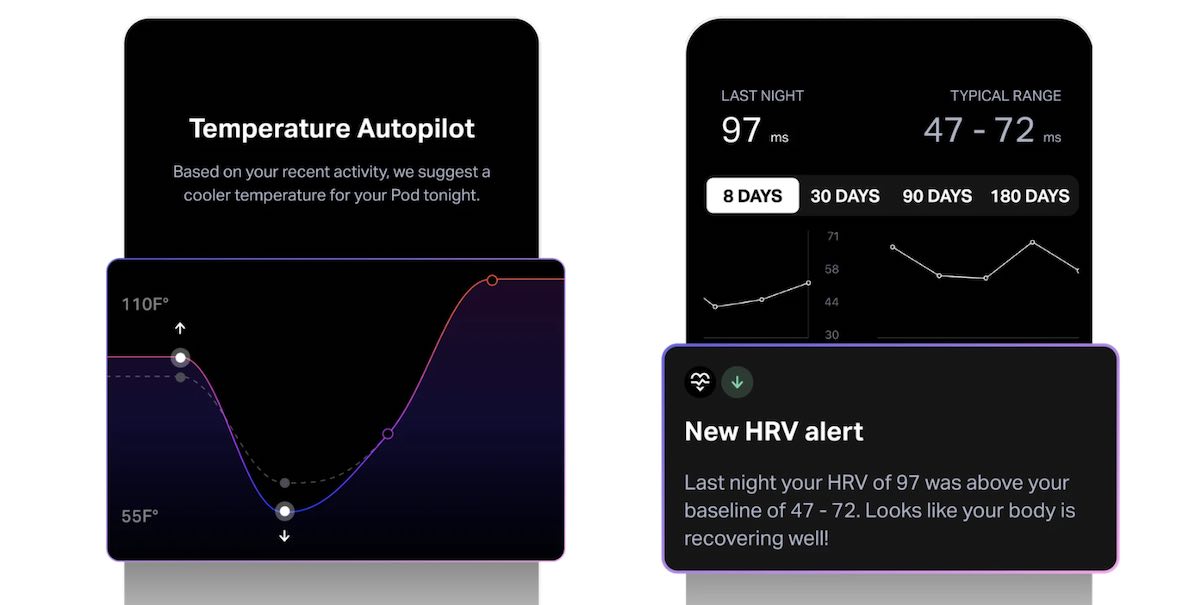
Based on your current sleep quality, ideal thermal environment, and ambient conditions, the Pod learns and automatically adjusts the temperature to optimize your sleep.
Although not exactly wearables, the products from Eight Sleep and similar companies are taking insights from sleep research and incorporating them into novel products for consumers.
Based on the numerous research papers, we think that any new features coming to the Samsung Galaxy 5 watch or the Apple Watch Series 8 about body temperature or nightly skin temperature will fall in one of the above buckets.
Let’s not forget a key number, 104 degrees Fahrenheit.
When your body/skin temperature reaches 104 degrees, you are susceptible to a heat stroke.
If you are an outdoor athlete, a wearable that provides continuous body temperature tracking as you workout can be a lifesaver!
Body Temperature Monitoring Use Cases Beyond Sports and Fertility Tracking
What does existing research suggest about the potential use cases for monitoring skin and core temperature?
There are numerous use cases for using body temperature to interpret different areas of health and wellness.
Here we look at five areas that have seen significant research and could find their way into tomorrow’s wearables.
Sickness Onset Monitoring
Measuring body temperature is one of the oldest clinical tools known to help diagnose infection.
When fighting an infection, your immune system powers up to fight it. Your body usually raises an inflammatory response.
Inflammation does exactly what it sounds like—“flame”—it heats your body.
Severe infections can even turn up the heat enough that your body generates a fever.
Changes in other related metrics such as an increase in Respiratory rate and resting rate and a decrease in heart rate variability (HRV) along with an increase in skin temperature could signal an existing infection or predict the onset of an illness.
Patients with CKD (Chronic Kidney Disease) who have to use dialysis can monitor skin temperature data points to prevent or check for infections.
Body Temperature role in Biofeedback / Stress Detection
Body Temperature could help refine some of the algorithms that drive stress detection.
In a relaxed state, the smooth muscles in the walls of the blood vessels usually also relax, which leads to more blood flowing to the extremities – we often recognize this by the feeling of warmth in the hands.
Thus, the onset of relaxation is accompanied by increased temperature in the extremities. Under stress or tension, the muscles in the vascular walls contract, the vessels become narrower and less blood reaches the extremities, often resulting in a drop in body temperature.
The body temperature usually reacts with some delay. From the beginning of the stress reaction to a drop in body temperature in the extremities may well take 1-2 minutes. Research has shown that dramatic exposure to stress in some individuals can cause psychogenic fevers.
Brown Fat and the overwhelming chatter
Brown fat, also called brown adipose tissue, is a special type of body fat turned on (activated) when you get cold.
Brown fat produces heat to help maintain your body temperature in cold conditions.
This has raised the prospect that such calorie burning can be translated into weight loss, particularly in the context of obesity.
Measuring Brown Fat requires PET Scans and MRI scans today. Still, a relatively inexpensive and noninvasive option is thermal imaging, which identifies hotspots of brown fat under the skin by monitoring the temperature of the overlying skin.
Numerous clinical trials have used inexpensive iButtons to monitor skin temperature.
We anticipate this to be a huge area of consumer interest in the future.
Studies have shown how brown adipose tissue is linked to a distinct thermoregulatory response to cold in people.
Metabolic Rate and body temperature
Research shows that higher core body temperatures appear to increase metabolism.
People with good metabolic health have more variation in daily temperature: their highs are higher, and their lows are lower.
They also have more consistency from day to day.
Keeping track of your body temperature can help you determine what kind of metabolic response your body has to a particular diet.
- Track your temperature as you lose weight.
- Measure your temperature at several points during the day to find your typical daily variation between your high and your low.
- Do it for a few days just in case something was weird the first time.
- Then you can measure again to track whether/how much your metabolic health is improving.
In a much-publicized study, Lewis Landsberg suggested that “Studies of body temperature in the obese under different circumstances (exercise, sleeping, after meals) are feasible and may reveal important differences between lean and obese. If this proves to be the case, a new therapeutic target, body temperature, may emerge.”
Landsberg emphasizes the potential role differences in the ability to maintain and defend core body temperature may play in weight gain.
It wouldn’t be surprising to see companies such as Levels or wearable makers such as Apple incorporate body temperature as a critical input into metabolic trends and their existing metrics such as Cardio Fitness levels.
Disease monitoring
An example is Raynaud’s Disease and its effect on body temperature.
It is estimated that 3 – 5% of the US population, predominantly women suffer from Raynaud’s disease.
The disease can cause some areas of your body — such as your fingers and toes — to feel numb and cold in response to cold temperatures or stress.
Impaired thermoregulation could lead to an episode.
Folks affected by this would benefit from monitoring their skin temperature using a wearable to prevent episodes.
The same applies to a large section of diabetes patients who have to periodically monitor their foot temperature to evaluate nerve damage and the likelihood of skin sores.
Sepsis prediction is another area where monitoring body temperatures can prove helpful. Body temperature is also associated with cognitive performance in older adults.
Final thoughts
In summary, the features related to body temperature monitoring with wearables such as smartwatches and smart rings are in their infancy.
That being said, there is a lot of interest and research in this area, primarily concerning sleep monitoring and fertility tracking.
We should begin to see some exciting offerings of services from wearable players. Companies at the forefront of research and related applications of body temperature include Oura Ring and WHOOP.
We expect additional offerings from companies such as Apple and Samsung over the next two years.
We hope that you found this article helpful. If we have missed any relevant research or wearables that aid body temperature monitoring, please let us know using the comments below.
We sometimes use affiliate links in our content from Amazon and others. It doesn’t cost you anything but helps us pay our expenses. Thank you for the support! Last update on 2024-04-24 / Affiliate links / Images from Amazon Product Advertising API

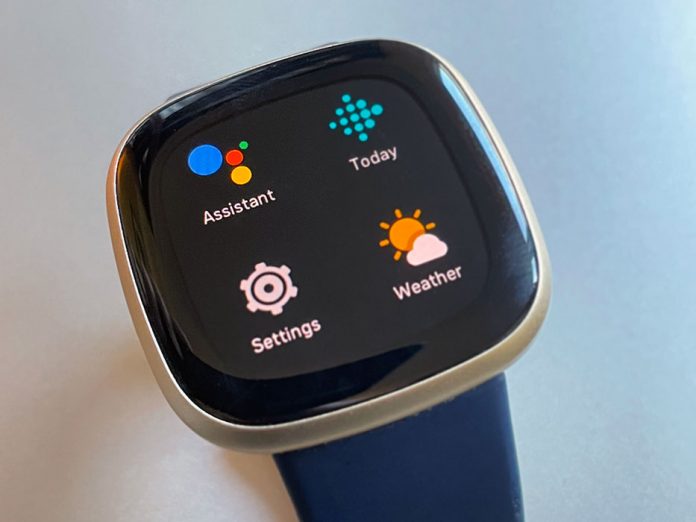

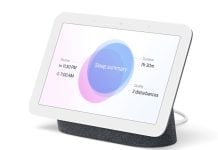
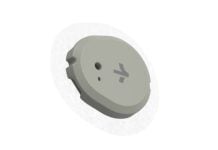
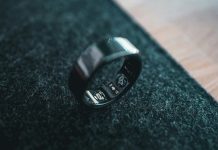



I’m more interested in monitoring my body/skin temperature at work.
More my core than my extremities. I work in a hospital lab, and we must wear plastic lab coats in rooms filled with analyzers pumping out heat.
I am constantly sweating, and it gets to the point where I’m lightheaded and nauseous.
But no one believes me because I always run hot.
And of course, I have a couple of coworkers that are always cold 🙄
I’ve called Maintenance too many times to count, and they always say the temperature is fine.
I need some way to show them I’m not lying. Any suggestions that won’t cost an arm and a leg?
Hi Kate,
Yeah, at this time, the Apple Watch won’t do that. But we’re fairly certain it will in the future–just not sure if that’s sooner or later.
For something that monitors your temperature passively during the day, there aren’t really any options. All wearables monitor only at night. So the best and cheapest alternative is to actively monitor your body temp at various points throughout the day, in your workplace. But that requires that you take your own temp and write a log–so not sure if your workplace will consider this as valid.
You could purchase a smart thermometer, which isn’t too expensive, and logs your temp directly into an app.